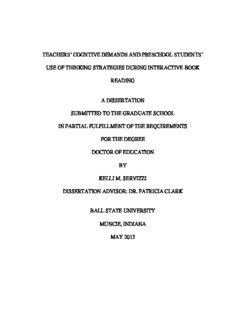
Following the Read Aloud PDF
Preview Following the Read Aloud
TEACHERS’ COGNTIVE DEMANDS AND PRESCHOOL STUDENTS’ USE OF THINKING STRATEGIES DURING INTERACTIVE BOOK READING A DISSERTATION SUBMITTED TO THE GRADUATE SCHOOL IN PARTIAL FULFILLMENT OF THE REQUIREMENTS FOR THE DEGREE DOCTOR OF EDUCATION BY KELLI M. SERVIZZI DISSERTATION ADVISOR: DR. PATRICIA CLARK BALL STATE UNIVERSITY MUNCIE, INDIANA MAY 2013 TEACHERS’ COGNTIVE DEMANDS AND PRESCHOOL STUDENTS’ USE OF THINKING STRATEGIES DURING INTERACTIVE BOOK READING A DISSERTATION SUBMITTED TO THE GRADUATE SCHOOL IN PARTIAL FULFILLMENT OF THE REQUIREMENTS FOR THE DEGREE DOCTOR OF EDUCATION BY KELLI M. SERVIZZI DISSERTATION ADVISOR: DR. PATRICIA CLARK APPROVED BY: ____________________________________ _______________ Dr. Patricia Clark, Committee Chair Date ____________________________________ _______________ Dr. Linda Taylor, Department Representative Date ____________________________________ _______________ Dr. Carolyn Walker Hitchens, Cognate Representative Date ____________________________________ _______________ Dr. Kathryn Fletcher, Cognate Representative Date ____________________________________ _______________ Dr. Clare Chatot, At-Large Member Date ____________________________________ _______________ Dean of the Graduate School Date BALL STATE UNIVERSITY MUNCIE, INDIANA MAY 2013 Copyright © Kelli M. Servizzi 2013 All Rights Reserved Thinking strategies during interactive book reading iv. Acknowledgements To the youngest learners who hold the promise for a more reflective class of teachers and a brighter picture of the future of education. To the professionals who engage children daily by valuing their conversations and their contributions and believing in their abilities. Thank you for allowing me to learn in your environment. To Dr. Patricia Clark. Thank you for chairing my committee and reading countless drafts. To Dr. Kathryn Fletcher. Thank you for guiding me through the analysis and providing partnerships for additional growth. To Dr. Linda Taylor. Thank you for sharing your love of early childhood. To Dr. Carolyn Walker Hitchens. Thank you for talking and working through the theories with me. To Dr. Clare Chatot. Thank you for your support and assistance throughout. To Dr. Linda Martin. Thank you for sharing your knowledge and encouraging and challenging me as a mentor and friend. To my parents, Mike and Sandy Rutherford. Thank you for instilling a love of learning and giving me a childhood that shaped the wife, mother, and teacher I am today. To my children, Jenna and Nathan. Thank you for your laughter, your hugs, and your kisses. You are a constant source of inspiration and constant reminder of the important things in life. To my husband, John. Thank you for the life we have built together. Your never-ending support made this journey possible. Three weeks from next Saturday. Table of Contents Page Acknowledgements iv. List of Charts ix. List of Tables x. Abstract xiii. Chapter 1 Introduction 15 Purpose of Study 19 Guiding Questions 19 Definition of Terms 19 Significance of Study 21 Limitations 22 Chapter 2 Literature Review Theoretical Frameworks 24 Preschool as an Early Intervention 29 Targeted Early Interventions High/Scope Perry Preschool Project 32 Head Start 35 Chicago Child-Parent Center Program 40 Carolina Abecedarian Project 41 Universal Early Interventions 43 Oklahoma Early Childhood four year old program 44 Cost Analysis 46 Classroom Read Alouds 47 Time 52 Read Aloud Style 53 Teacher Behavior and Student Engagement 55 Questioning 57 Student Language 59 Developing Comprehension in Young Children Metacognition 62 Scaffolding 65 Thinking Strategies 74 Inclusive Special Education Classroom 80 Inclusion 82 Language and Communication 83 Social Integration 86 Conclusion 89 Chapter 3 Methodology Purpose 90 Participants 91 Research Design 94 Procedures 96 Data Analysis 97 Chapter 4 Results Introduction 99 Guiding Questions 100 Read Aloud Descriptions 100 Time 113 Question 1 115 Question 2 126 Chapter 5 Conclusion and Discussion Summary 129 Conclusions 131 Limitations 132 Discussion 133 Implications for Practice 137 Recommendations for Future Research 138 Final Thoughts 140 References 141 Appendix A Parent Permission 154 FERPA Authorization 156 Student Assent 158 Appendix B Teacher Consent 160 Appendix C Reading Protocols Read Aloud 1 163 Read Aloud 2 164 Read Aloud 3 169 Read Aloud 4 174 Read Aloud 5 178 Read Aloud 6 183 Read Aloud 7 188 Read Aloud 8 192 Thinking strategies during interactive book reading ix. List of Charts Page Chart 1 59 Percentage of teacher utterances by question type Chart 2 60 Types of talk in Head Start classrooms Chart 3 114 Time spent on interactive book reading in classroom No. 1 Chart 4 114 Time spent on interactive book reading in classroom No. 2 Thinking strategies during interactive book reading x. List of Tables Page Table 1 27 Seven assumptions to the Sociocognitive Model Table 2 34 High/Scope Perry Preschool participants vs. non-participants at age 40 and age 27 Table 3 55 Interactive teacher behaviors Table 4 61 Adult-student interactions Table 5 68 Tactics for teaching deep structure comprehension Table 6 75 Thinking strategies used by proficient learners Table 7 116 Thinking strategies used in classroom No. 1, Read aloud 1 Table 8 116 Thinking strategies used by child in classroom No. 1, Read aloud 1 Table 9 117 Thinking strategies used in classroom No. 2, Read aloud 1 Table 10 117 Thinking strategies used by child in classroom No. 2, Read aloud 1
Description: